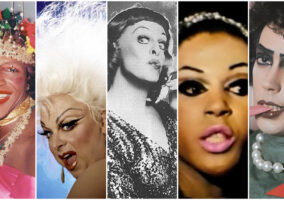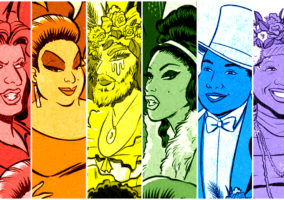
As we noted in our piece on Stormé DeLarverie, so much of queer history and the development of queer culture went unrecorded and unexamined by historians, journalists, and even queer contemporaries. What we are left with most often when talking about our queer forebears in the pre-Stonewall era are myths and legends. This is largely true of the legend of Crystal LaBeija, although there was just enough of an historical record left behind for us to piece together just how revolutionary and far-reaching her actions were.
Crystal was a pageant queen formerly known as “Crystal LaAsia” who eventually switched it to LaBeija because LatinX queens kept calling her “la belleza.” In 1967, with a Miss Manhattan sash to her name (among other wins), she participated in the Miss All-American Camp Pageant in New York. The pageant was being recorded (HIGHLY unusual for any drag or queer event at the time) for a documentary about the pageant specifically and drag queens generally called The Queen, which would premiere at Cannes the following year (before mostly dropping out of sight and becoming a cult classic in the video age). Crystal made quite an impression in the film when, after being called as the third-runner up in the pageant, she simply walked off the stage, in full view of the judges (one of whom was Andy Warhol), the entire audience, and thankfully, the cameras. The pageant crown went to a pretty, blonde, realness-serving queen named Harlow and Crystal felt that her win had been a given from the start and that all the rest of the queens were being passed by for another pretty white girl. The drag pageant system of the 1960s was – no surprises here – extremely tilted toward white participants and most queens of color were ignored by the judges. Despite the constant racism she faced in the pageant world, Crystal was known to have racked up quite a few wins over the years. That is also not such a surprise when you see the few remaining pictures of her. She was striking and glamorous and as we’ll see in a minute, she had nerve and charisma to spare.
The cameras followed Crystal as she gracefully walked off the stage of the Miss All-American Camp pageant. When she was asked to give her thoughts on what just went down, Crystal, clearly fed up with a racist system that constantly pushed her and her sisters aside, was all too happy to give them. Children, we proudly present to you one of the earliest – and still one of the finest – legendary reading sessions ever recorded:
Now. We won’t sit here and analyze every word of this legendary read and explain why it’s the urtext of drag (that’s what the book’s for). If things had ended here, if Crystal had done nothing else of note in her life, these few minutes of pure drag queen shade (at a time when no one even knew the word “shade” existed for what she was doing) might not even have been remembered. But like all great revolutionary thinkers and rebels, Crystal turned her anger into action and that action changed the world.
Believe it or not, the drag ballroom scene depicted in Paris is Burning and recreated in Pose was also largely white-oriented and white-centered at this time, with trophies and praise routinely showering down on the white queens while the queens of color stood on the sidelines. The gay “masquerade balls” of Harlem date back to the latter 19th Century and like so much of 20th Century New York social scenes, had always been dominated and organized by white people. Crystal, like a lot of competitive queens in the drag world of the time, bounced back and forth between both arenas in her career and she was no less pissed off by her struggles for recognition in the ball world than she was in the pageant world. The difference was, she could do something about the ball world.
In 1977, she and her friend Lottie (who, legend has it, worked with Crystal at the welfare office) were fed up with letting white people run the balls and decided to throw one of their own, specifically for queer people of color, at a Harlem bar called Up the Downstairs Case. They printed a flyer: “Crystal & Lottie LaBeija presents the first annual House of LaBeija Ball at Up the Downstairs Case.”
And just like that, the first House of the ball scene was formed and Crystal was designated the first mother. That first LaBeija Ball must’ve been a hell of a success, because in rapid succession, legendary houses with legendary mothers and fathers sprung up soon after: The House of Dupree, the House of Xtravaganza, the House of Corey, the House of Ninja and so on, all the way up to the present day. The ballroom scene as we know it today coalesced around Crystal’s actions and anger and is now a worldwide scene with its own forms of art and expression, centering the voices, movements and experiences of people of color worldwide. Crystal’s choice to form her own house and throw her own ball casts her earlier reading session into context. She wasn’t just mad in that moment; she was clearly mad and fed up about being marginalized for years and years, until she finally said “To hell with it, I’ll throw my own goddamn ball.” That’s often how revolution works. People don’t necessarily write manifestos to affect change; they simply get pissed off enough to do something about it. Drag queens don’t need manifestos. After all, what is a legendary read but a form of drag manifesto?
Crystal LaBeija died in 1982 of liver failure. Today, the House of LaBeija still stands as one of the iconic houses of the ball scene.
Aja did a pitch-perfect Crystal impersonation for the Snatch Game in season 3 of RuPaul’s Drag Race All-Stars:
A remastered version of The Queen is being released in theaters later this month:
“Our book Legendary Children: The First Decade of RuPaul’s Drag Race and the Last Century of Queer Life is on sale now!
The Los Angeles Times called it “a nuanced exploration of the gender-bending figures, insider lingo and significant milestones in queer history to which the show owes its existence.” The Washington Post said it “arrives at just the right time … because the world needs authenticity in its stories. Fitzgerald and Marquez deliver that, giving readers an insight into the important but overlooked people who made our current moment possible.” Paper Magazine said to “think of it as the queer education you didn’t get in public school” and The Associated Press said it was “delightful and important” and “a history well told, one that is approachable and enjoyable for all.”
Cathy Cambridge Gets Her Sparkle On at the Action on Addiction Dinner Next Post:
“Shaft” Star Regina Hall in L’Agence at BUILD Series
Please review our Community Guidelines before posting a comment. Thank you!


